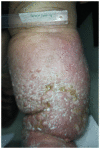An integrative therapeutic approach to elephantiasis nostras verrucosa: A case report
- PMID: 35317434
- PMCID: PMC8908468
- DOI: 10.3892/etm.2022.11218
An integrative therapeutic approach to elephantiasis nostras verrucosa: A case report
Abstract
Elephantiasis nostras is a chronic disorder that is difficult to treat. It is characterized by marked lymphedema, associated with hyperkeratosis, ulceration, deep skin folds and a cobblestone appearance of the skin. Causes include parasitic and bacterial infections, neoplasia and obesity, but numerous cases have uncertain aetiology. Treatment includes surgery and medication, which are associated with variable results. In the present study, a 72-year old female with renal insufficiency presented with leg enlargement of 3-4 years duration, which rendered her housebound. Examination showed massive lower limb enlargement, with typical cobblestone appearance. She was on furoseminde 80 mg/day. A diagnosis of elephantiasis nostras was made. Then, she was treated with increased furosemide from 80 to 120 mg daily and homeopathic Apocynum cannabinum, CH30 potency, t.d.s. Unavailability of corresponding fit excluded the use of compressive stockings. The patient remitted over 18 months, with limb diameters dropping from 68/46 cm (right mid-calf/ankle) and 67/43 cm (left mid-calf/ankle) to 64/43 cm (right mid-calf/ankle) and 64.5/45 cm (left mid-calf/ankle) at 6 months, 63/42 cm (right mid-calf/ankle) and 65/41 cm (left mid-calf/ankle) at 12 months, and 46/35 cm (right mid-calf/ankle) and 48/36 cm (left mid-calf/ankle) at 18 months, with improvement of skin appearance. Elephantiasis nostras is not spontaneously remitting. In this resource-limited setting, furosemide combined with homeopathic Apocynum cannabinum has proved valuable and may be used for similar cases.
Keywords: Apocynum cannabinum; elephantiasis nostras; furosemide; homeopathy; integrative medicine; lymphedema.
Copyright: © Nwabudike et al.
Conflict of interest statement
The authors declare that they have no competing interests.
Figures




Similar articles
-
Elephantiasis nostras verrucosa or "mossy foot lesions" in lymphedema praecox: report of a case.J Am Podiatr Med Assoc. 2008 Jan-Feb;98(1):66-9. doi: 10.7547/0980066. J Am Podiatr Med Assoc. 2008. PMID: 18202337
-
A Case of Elephantiasis Nostras Verrucosa Secondary to Lymphedema Praecox Complicated by Congestive Cardiac Failure.Am J Case Rep. 2021 Mar 14;22:e930269. doi: 10.12659/AJCR.930269. Am J Case Rep. 2021. PMID: 33714971 Free PMC article.
-
Elephantiasis Nostras Verrucosa in a Patient With Lymphedema Tarda.Cureus. 2024 Mar 24;16(3):e56850. doi: 10.7759/cureus.56850. eCollection 2024 Mar. Cureus. 2024. PMID: 38659539 Free PMC article.
-
Excision of Elephantiasis Nostras Verrucosa Lesions in a Patient With Hereditary Lymphedema: Case Report and Review of the Literature.J Foot Ankle Surg. 2015 Jul-Aug;54(4):747-50. doi: 10.1053/j.jfas.2014.08.010. Epub 2014 Oct 16. J Foot Ankle Surg. 2015. PMID: 25441846 Review.
-
Hypothyroid Graves' disease complicated with elephantiasis nostras verrucosa (ENV): a case report and review of the literature.Endocrine. 2009 Aug;36(1):6-9. doi: 10.1007/s12020-009-9200-4. Epub 2009 Apr 24. Endocrine. 2009. PMID: 19390996 Review.
References
-
- Molodoi AD, Dimitriu A, Andronic CD, Stoleriu G, Bădescu A, Boda D, Branisteanu DE. Pyoderma vegetans developed on chronic leg ulcer. Rev Med Chir Soc Med Nat Iasi. 2015;119:107–111. - PubMed
Publication types
LinkOut - more resources
Full Text Sources
